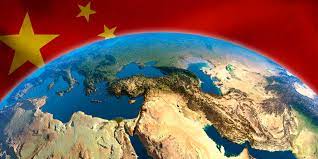China’s plan to expand use of its currency for oil trading with six Middle Eastern countries will elevate use of the yuan in global commerce among friendly countries and futures traders drawn by its stable exchange rate, market analysts forecast.
But while that may lead to more yuan-for-oil deals – largely so China can buy fuel without intervention from the United States – experts say the shift will not offset use of the petrodollar or substantially boost the yuan’s use outside energy markets.
“China and the Middle East in the past would use US dollars as their long-term currency,” said Zhao Xijun, associate dean of the School of Finance at Renmin University in Beijing.
“But in face of geopolitics and US sanctions in the finance space, so few countries are considering whether they can use other currencies to settle oil and gas accounts.”
The number of yuan deals should rise, however, because China – the world’s biggest buyer of oil – would ask exporters to use its currency, Zhao said.
Other parts of the world will catch on if yuan exchange procedures are convenient and the Chinese currency is regarded as “safer” than the dollar, he said. Among the candidates are Hong Kong, Singapore and some European nations.
Chinese President Xi Jinping proposed last week at the China-Arab Summit to boost oil and gas settlements denominated in yuan with the six Gulf Cooperation Council states within three to five years.
China will plough more yuan into the Middle East as the world’s biggest manufacturer, China International Capital Corporation (CICC) said in a research note on Tuesday. The country consumes on average about 15.4 million barrels of oil per day, only behind the United States.
“Oil trade settlement has helped the internationalisation of the US dollar, and we believe that the settlement of oil trade in [yuan] will also help the internationalisation of the [yuan],” the CICC said.
Trade between China and the Arab world has grown 1.5 times over the past 10 years, Ministry of Foreign Affairs spokeswoman Mao Ning told a media briefing last week. In the first three quarters of 2022, she said, bilateral trade reached US$319.3 billion, up 35.3 per cent year on year.
“Cross-border yuan payment has played an important role in boosting trade between China and Arab states,” Mao said.
Future oil trade would resemble China’s existing yuan settlements for palm oil and rubber from Malaysia as part of a government-to-government agreement, said Song Seng Wun, an economist with CIMB Private Banking.
China and the Bank of International Settlements established a yuan reserve pooling system in June with central banks in Malaysia, Indonesia, Singapore and Chile, as well as the Hong Kong Monetary Authority. More central banks will participate in the future, said UBS North Asia economist Deng Weishen.
In Russia, the yuan surpassed the US dollar for the first time in October to become the most traded foreign currency on the Moscow exchange.
“The US dollar is still the dominant currency of trade, but it’s an obvious insurance policy to not rely just on the US currency,” Song said.
China is keen for more use of its currency to ensure oil supply in case the US targets it financially as part of their long-running trade and political disputes, he said. The US and its allies, for example, took Russia out of the SWIFT interbank payment system in March after it invaded Ukraine.
“The Middle East is just an extension of what we see happening all around,” Song said.
Oil futures traders may prefer to pay yuan because the currency does not fluctuate in sync with the global market movement that decides the dollar’s exchange rate, said Danny Ho, an economist and chief executive of the DMI energy consulting firm in Taiwan.
The People’s Bank of China sets a daily reference rate, around which the yuan can rise or fall 2 per cent either side.
Oil traders who buy futures – meaning the price per barrel is fixed over a year or more – would see the yuan as a “hedge” against risk, Ho said.
They would hope in particular to avoid a repeat of April 2020, when West Texas Intermediate crude oil prices fell into negative territory, he said.
But the yuan will not replace the petrodollar as Middle Eastern exporters find the US currency to be their easiest way of investing proceeds from sales. Western countries and importers in Asia outside China still widely use it, Ho said.
“It’s a long way to go before we can say there is such a thing as petro-renminbi,” said Chen Zhiwu, chair professor of finance at the University of Hong Kong.
Expanded use of the yuan to buy Middle Eastern oil and gas could nudge the currency forward in other sectors, some experts say. Trade partners might use the yuan to buy more goods from China or make investments, including in stocks, Zhao said.
But the currency’s global profile will stay low because China wants to continue controlling its international exchange rate, analysts say.
A fixed rate ensures income for domestic traders, especially exporters of manufactured goods, and helps stabilise the Chinese economy by heading off exchange rate volatility.
“I don’t think they’re terribly concerned or enthusiastic about [easing controls],” said Jayant Menon, a visiting senior fellow with the ISEAS-Yusof Ishak Institute’s Regional Economic Studies Programme in Singapore.
The use of the yuan in other types of trade hinges on overseas demand for Chinese goods and whether trade partners find the currency viable for hedging or reserve use, said Nick Marro, Hong Kong-based lead Asia-Pacific trade analyst with The Economist Intelligence Unit market research firm.
Under today’s currency controls, he said, “we probably won’t see meaningful progress in renminbi internationalisation at the global level” even with growth in yuan oil trade.
“The best example to watch might be what happens between Russia and China, given that an expansion in yuan-denominated trade flows has partly been accelerated by geopolitical urgency,” he said. “But those same dynamics aren’t present when we talk about, say, China’s trade relationship with Saudi Arabia.”
Chinese officials still consider yuan internationalisation a political “prize” but lack the resolve to loosen controls, Chen said.
“I can see they would like to rely on the dollar less, which is entirely rational,” Chen said.
But he added: “From an economic perspective it is hard for me to see that the [yuan] would be a big international reserve currency or even a trade currency in the near future.”

 Iran Energy News Oil, Gas, Petrochemical and Energy Field Specialized Channel
Iran Energy News Oil, Gas, Petrochemical and Energy Field Specialized Channel



